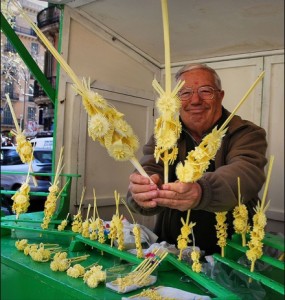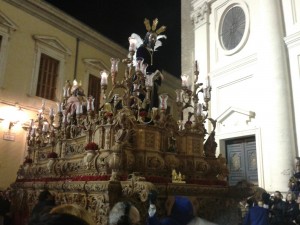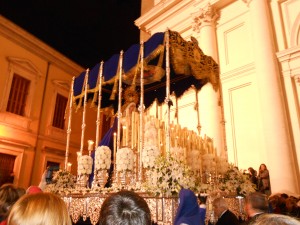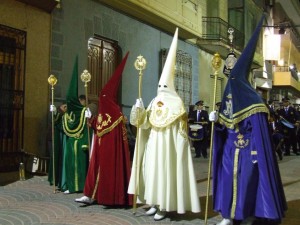
On Palm Sunday, street vendors all over Spain sell elaborate palm sculptures. They're a big hit with the local children!
Every once in a while, there’s a moment when I realize just how American I am, despite the fact that I sometimes like to convince myself that I’m slowly becoming Spanish. For example, yesterday in class, we were discussing Easter traditions. It was pretty funny when we tried describing the purpose of the Easter Bunny to our international classmates and our Spanish professor, and honestly couldn’t find a real reason why we celebrate Jesus’ resurrection with a giant, egg-bearing rabbit. Luckily, though, America isn’t the only nation that celebrates this time of year with traditions that seem a bit strange to other cultures. Some of the primary elements of Spain’s take on Easter are equally (if not more) surprising, especially when seen through American eyes.

The Paso depicting Jesus being led to Pilate by the Romans. It was carried from underneath on the necks of around 30 people.
Being a nation that declares itself primarily Catholic, one of the most important weeks of the Spanish calendar is the Semana Santa, or as we know it in the States, Holy Week. The seven days leading up to the resurrection of Jesus Christ are celebrated much more publicly here than they are in America, and range in extravagance depending on the region of the country that you’re in. For example, in Zamora (central-northwest Spain), members of religious brotherhoods can be seen throughout the week re-enacting the crucifixion of Jesus or performing public acts of penance, complete with wearing shackles and wailing in the street, until Easter Sunday. In Málaga (southern Spain), the week is much less somber, often filled with flamenco music, tourists, and cause for daily celebration. Zaragoza’s Semana Santa is more of a “happy medium” between the two extremes, and is a good representation of what a generally traditional Spanish Semana Santa consists of.
Throughout the week, there are a number of massive processions consisting of anywhere between 100 and 400 people that wind through the streets and draw huge crowds. The grand jewel of each individual procession is the Paso: an expansive, heavy wooden float depicting either Jesus or the Virgin Mary (or both), usually covered in flowers, beads, candles, and rich fabric. Sometimes these tributes to Christ are rolled on wheels, but other times they’re carried from underneath by large groups of local men, who rest the burden on the backs of their necks as a representation of Jesus carrying his cross to Calvary. The Paso is usually accompanied by different groups of people involved in the procession, including priests bearing incense, trumpeters and other brass instrumentalists, and of course, hundreds of Nazarenos.
This is the part where I get to explain what I meant earlier about how there are just some Spanish Easter traditions that will always seem strange to an American. In fact, if you don’t know much about the history and significance behind the Nazarenos, you’re likely inclined to find them downright terrifying. In the bluntest of terms, they look eerily like more colorful members of the Ku Klux Klan, and seeing them gave me a serious case of the heebie-jeebies. Usually made up of members of a religious brotherhood, the Nazarenos march in the processions during the Semana Santa cloaked from head to toe in tunics and capirotes, (pointed hoods that cover their faces entirely and only have eye holes cut out) as part of a tradition that dates back to the middle ages. The purpose of the KKK-esque getup was originally to show reverence for Christ’s crucifixion without glorifying their individual identities, and it’s still continued in that manner today throughout the country.
The procession of the Nazarenos into the Catedral La Seo (Click here)
The majority of the Nazarenos play a forceful drumming routine as they proceed throughout the city, and it’s both a haunting and intriguing thing to see in person. When I got to witness a number of these processions on Sunday, I was with one of my friends who has lived in Zaragoza all of his life, and he kept cracking jokes about how much the Nazarenos scare Americans. (He also taught me the majority of the information that I put in this post… so thanks for the education on the Semana Santa, amigo!) Overall, if I took anything away from learning about the Semana Santa, it’s how amazing it is to really take note of the meaning behind tradition. For example, it’s crazy to see that something SO offensive and negatively associated in the States (like the pointed hood of the Nazarenos) is considered to be a sacred, incredibly important historical and religious symbol elsewhere. Just one more example of how fascinating cultural differences can be, from the Easter Bunny to the streets of Spain, and everywhere in between.


Leave a Reply